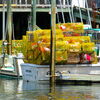Processing Your Payment
Please do not leave this page until complete. This can take a few moments.
Ship shape | With its launch into military speedboats and custom yacht interiors, Hodgdon Yachts sails toward calmer waters
Over 192 years, Hodgdon Yachts has made a number of good decisions. While other Maine boat builders have fallen by the wayside over the years, the East Boothbay company has survived swells natural to the boatbuilding business to keep making schooners, motorsailer ketches, arctic explorers or whatever the market winds dictated.
In the more recent past, Hodgdon Yachts has focused exclusively on crafting high-end luxury boats — the kind of ship that would be a fashionable Manolo Blahnik high-heeled boot if it were a shoe. Although these sleek wooden yachts have kept the company in business, the demand for them is far less than for fiberglass, steel or aluminum yachts, says Chief Operating Officer Andy Wright.
Only about one new mega-yacht per year in the world is made from wood, which makes for a more durable — but heavier and slower — craft, Wright explains. If Hodgdon focused only on these boats, "the business would be up and down and inconsistent," he says.
To even out business, and to help the company grow, owner Tim Hodgdon decided several years ago to change course and expand into two new markets: yacht interiors and military vessels. And he's leapfrogging the fiberglass age to the composites era, which has become the cutting edge of boat building but also carries risks for boat builders. (For more on Maine's composite boat industry, see "Lighter, faster, more expensive," page 19.) In January, the yard finished its first carbon-composite patrol boat for the U.S. Navy and is in the process of building two yachts with lightweight carbon fabric and high-density PVC foam hulls.
"It's about diversification for our shipyard," Hodgdon says. "We have developed a strong brand for quality and innovation, and as we look toward the future, we see many opportunities."
Hodgdon Yachts, which will continue making yachts in its East Boothbay headquarters, in March expanded to a new facility in Richmond to build yacht interiors for larger shipyards. The company in January completed a patrol boat prototype to try to break into the military market, and is waiting for feedback from the U.S. Navy after it finishes testing the vessel.
The company has benefited from its history on Maine's coast and from the state's reputation for quality workmanship. In 2006, Maine's shipbuilding industry, which includes 72 companies, not including shipbuilder Bath Iron Works, posted $350 million in sales and employed about 2,500. "We're a little bit of an unknown secret," boasts Jane Wellehan, president of the nonprofit industry group Maine Built Boats.
Hodgdon Yachts has also partnered with the University of Maine to create a cutting edge carbon-Kevlar composite hull. Wright says the school's Advanced Engineered Wood Composites Center has been critical to the company's progress in this area.
Tim Hodgdon, who is the great-great-grandson of company founder Caleb Hodgdon and a fifth-generation owner of the yard, took over the company from his father in the mid 1980s. Early on, he picked up the company's pace by adopting a specialized cold-molding construction method, which entails wrapping a hull form with layers of thin wood, to build durable yachts for the growing class of the super-rich.
"My father was a traditional plank-on-frame kind of guy," Hodgdon says. "Back in those days, my father was running a small operation, a company of three or four. We have evolved the company into sophisticated techniques. It's cutting edge."
These days, Hodgdon Yachts employs 90. The company did not release revenue figures, nor would it say how many boats it builds in a typical year, noting that orders fluctuate and the length of time it takes to build a boat varies. (The boats, however, are undeniably pricey: Though Hodgdon Yachts officials wouldn't say how much the average boat costs, the 154-foot yacht Scheherazade, which was launched in 2003, is listed by U.K. yacht brokerage Burgess for 22 million euros, or about $34 million.)
Now, as Hodgdon Yachts prepares to grow, the odds are good it will continue to push Maine's boatbuilding heritage forward. "There are all sorts of people trying to build yachts," Hodgdon Yachts Marketing Director Ted Smith says. "Very few have been at it the length of time we've been at it."
Richmond, ho!
To build yacht interiors, Hodgdon Yachts has leased a long, low manufacturing facility on the outskirts of Richmond's Main Street, which heads toward Route 295. The company is investing $1.1 million to outfit the 28,000-square-foot facility and expects in the next two years to hire 35 new workers, as well as transfer 15 workers from its East Boothbay yard. The building also is next door to Richmond's middle and high schools, and the company plans to offer an apprenticeship program for students.
One reason Hodgdon Yachts expanded inland was to find workers. A recent survey by Maine's North Star Alliance Initiative — a federally-funded economic development program for the boatbuilding, composites and marine trades — noted that a shortage of workers is among the highest barriers to sustained business competitiveness for boatyards.
Smith says that Hodgdon's East Boothbay yard, a remote 14 miles at the end of a long peninsula crowded with expensive real estate, has made it difficult to attract prospective workers. In Richmond, on the other hand, the company can draw on a labor pool that starts locally and expands out to Augusta, Gardiner, Brunswick, Portland, Lewiston-Auburn and Rockland.
The move to Richmond also helps solve a workflow problem at Hodgdon Yachts. Since the production cycle of a yacht can last three years, it can be difficult for a shipyard to maintain staff between big jobs. "It adds another arrow to our quiver," Smith says. "And we can enter a different market and diversify, so we can stabilize the workforce. It takes the peaks and valleys out of production."
The Richmond expansion could double the size of the business over the next two to three years, according to Wright. The company hopes to add more than 100 workers in East Boothbay and Richmond in five years. "There's that much revenue potential," he says.
Newcastle Marine in Florida, which specializes in large motor yachts, already has commissioned a cherry-wood interior, responding to a mailing Hodgdon put out two years ago to test demand. Hodgdon also has a letter of intent from another southern company, which it declined to name. "We have developed a relationship with two boatyards, and they want us to build numerous interiors for them in the future," Wright says, explaining that it's common for larger shipyards to commission smaller ones for parts work. Hodgdon, however, typically subcontracts on a case-by-case basis. Because every ship requires a lengthy time commitment, it is difficult for shipbuilders to predict future projects. Typically, an interior for a $20 million to $30 million yacht will be 30% to 40% of the total yacht's cost. But different owners ask for different details, and the final cost varies. One might want granite counter tops, another marble. "Some of them get really extravagant," Wright says.
The Navy angle
Hodgdon's leap from pleasure boats to warships might seem a bit of a stretch at first. "How much more diverse can you get?" asks Wellehan of Maine Built Boats before adding that a diversified company is a "much safer way to go" than operating in a narrow niche.
Hodgdon Yachts has a history making military crafts, including building submarine chasers during World War II and minesweepers during the Korean War. But it has not touched a warship since the 1950s. For the past century, the yard has specialized in yachts.
But in the late 1990s and early 2000s, Hodgdon Yachts began paying closer attention to Navy reports that SEALs were suffering back, neck and joint pain, as well as chipped teeth, after riding in their aluminum Mark V speedboats. Believing it could design a ship that could reduce the jolts of such boats, Hodgdon Yachts in 2003 developed a plan with the University of Maine's Advanced Engineered Wood Composites Center.
Instead of using aluminum, which does nothing to cushion passengers from the impact of pounding waves at high speeds, the boatyard and AEWC Center redesigned the Mark V hull and built it from a carbon-Kevlar composite with a middle layer of foam. "Think about running in aluminum shoes versus foam soles," says Bob Lindyberg, the AEWC Center's assistant director for boat building and composites.
The new Mako, which was funded with $14 million from the Office of Naval Research, was launched in January. Hodgdon Yachts expects to hear feedback from the Navy in August. If the Navy contracts with Hodgdon for a new fleet of the boats, which are used to patrol coastlines and drop SEALs off on combat missions, the company could be looking at a $200 million contract to build 16 new vessels.
Lindyberg believes the boat should give Hodgdon an advantage in winning a Navy contract. Although Hodgdon has no direct competitors, Lindyberg says that if the Navy wants the carbon-composite boat, it'll likely put the project out to bid. "What the project has done is developed a real state-of-the-art technology embodied in a Maine company," he says. "Now a Maine boatbuilding company is a very viable competitor."
In 2004, Hodgdon formed a subsidiary, Maine Marine Manufacturing, specifically to pursue military contracts. Led by David Packhem, the company is considering leasing a 16-acre plot of empty land owned by the city of Bangor in Hampden to construct the vessels, which it could then sail down the Penobscot River. Besides the Mako, the company is also developing other shore patrol boats that might appeal to the U.S. Coast Guard, Navy or friendly foreign nations.
"There is a lot of smuggling and terrorism," Packhem says, noting dangers such as pirates off the coast of Somalia and trouble spots among Pacific Rim countries. "All of these countries need to protect their coastlines, and we believe these boats could be the boats they use."
The Mako, which is designed to hit high speeds on the open water — the Navy won't allow Packhem to say exactly how fast it goes, but he says it's more than 50 knots an hour — might also appeal to private owners. "People might think of this as the Hummer of the waves," Packhem says.
The high-tech boat is the first of many carbon composite boats the yard will make, Wright says. Already, the company is getting more inquiries from interested private customers who want a speedy, lightweight craft. "[The technology] has opened up a whole new market to us," Wright says. From now on, he expects the breakdown of Hodgdon boats to be 80% carbon, 20% cold-molded wooden yachts.
Although the East Boothbay yard looks different these days, its nature still recalls the past. And local historian Barbara Rumseym, for one, appreciates the lasting presence of Hodgdon Yachts in East Boothbay, which now resembles a tourist trap more than a shipbuilding village. "Hodgdon yards keeps the historic feel of the village because it's a functioning yard," Rumsey says. "It's not the workingman's place it used to be, but Tim does what he can to keep it that way."










Comments